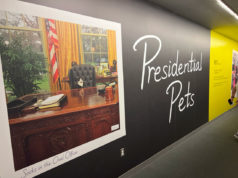Anyone who’s checked out conceptual artist Janet Morrow’s current show Ambiguous Belonging at the Fort Worth Community Arts Center was probably intrigued and a little mystified by its contents. Long, soft polyester tubes dangle like clusters of arms and legs from the ceiling. Alongside these soft sculptures are wall-mounted digital photos showing closeups of industrial scenes, including pieces of machinery like metal and plastic pipes, tubes, bolts, wheels, and wires.
With the contrast between the warm polyester tubes and cold industrial parts, Morrow might be talking about a lot of things, including the way flesh-and-blood humans and plastic-and-metal machines interact in unexpected ways. But another major theme, or at least a big influence, in her work is disability, especially deafness and the profound hearing loss that has happened to her in mid-life. Over the course of 15 years, Morrow, 54, developed a near-total deafness, an impediment only partially alleviated by cochlear implants. In her mind, she is now part human and part complex machine, and this inspires many of the ideas in her sculptures, drawings, and installations that, over the last few years, have won awards and been shown in Minneapolis, Austin, New Jersey, Maryland, England, and Washington, D.C.
“Nowadays the way for everyone to function is to embrace technology so you can communicate with people,” Morrow said. “Well, I have taken technology into my body. When I started working [in art] with themes of deafness and disability, I didn’t want to address just deaf people. I find that everyone has situations where they feel that their communication has been hampered.”
For most of her life, Morrow harbored no ambition of becoming a visual artist. The Tennessee native earned a bachelor of fine arts degree in theater arts from Southern Methodist University in 1979, but upon graduation she decided that a life onstage wasn’t in the cards for her. Much of her adult professional life was spent working for American Airlines, as everything from a flight attendant to an account manager. Later she quit the airlines and went to work for Blockbuster Entertainment.
The deafness that changed her life didn’t begin until she was 39, and it started gradually. Doctors diagnosed her in 1998 with auto-immune inner-ear disease, triggered by a virus that causes only mild hearing impairment for most people. The doctors told Morrow that her hearing loss likely wouldn’t be significant until she got much older.
After she got that diagnosis, she remembered sitting on her patio, “listening to the wind in the trees” and trying to imagine a time in her life when she wouldn’t be able to hear.
Turns out the doctors had miscalculated both the speed and severity of Morrow’s deafness. Starting in 2000, the hearing loss in both ears became so profound that she could barely understand speech. In 2005, after struggling with the full extent of her condition, Morrow quit her job at Blockbuster and signed up for classes at Tarrant County College. She studied graphic design, which led to fine arts courses, including drawing and painting, that fired her imagination in unexpected ways and inspired her to create the works that have been displayed across the country.
Her sculptures and installations have been greatly informed by the feminist theorist Donna Haraway, especially Haraway’s book A Cyborg Manifesto: Science, Technology, and Socialist Feminism in the Late Twentieth Century. The author uses the sci-fi term “cyborg” in a very broad and realistic way, believing that as more people use things like electronic implants and prosthetics to complete their lives, human beings are growing toward a more intimate, commingled relationship with technology.
Morrow is still working on her MFA at the University of Texas at Arlington; this year she’s begun teaching drawing classes to undergraduate students. It’s been gratifying to use her relatively newfound artistic skills to help young students develop theirs, she said. She believes her disability helps her to be more patient with the students’ own differences and challenges. But as an artist, Morrow has no interest in dealing exclusively with the subject of deafness and disability. Her art is more complex than that.
“When I began as an artist, the subject of hearing loss was more explicit,” she said. “Now it’s more abstract. It informs my thought process, but I’ve moved on to other ideas. If people can get some completely different kind of effect [than exploring disabilities] from it, that’s great.”
[box_info]
Ambiguous Belonging
Thru Mar 29 at the Fort Worth Community Arts Center, 1300 Gendy St, FW. Free.
817-738-1938.
[/box_info]












